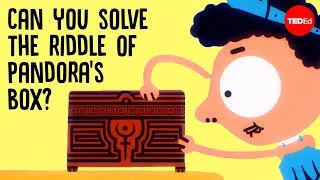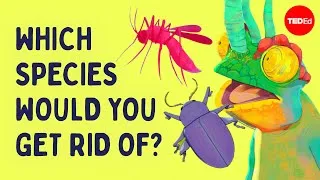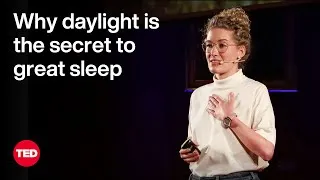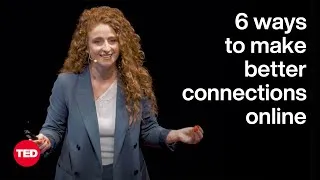請雙擊下方英文字幕播放視頻。
譯者: Lilian Chiu
審譯者: Helen Chang
00:07
Imagine opening a bag of chips only
to find Santa Claus looking back at you.
0
7128
4546
想像一下,打開一包洋芋片,
卻發現聖誕老人回望著你。
00:11
Or turning the corner to see
a smile as wide as a building.
1
11924
3838
或者走過街角,看到
建築物咧嘴對你微笑。
00:16
Humans see faces in all kinds
of mundane objects,
2
16345
3379
人類會在各種平凡的
物體上看到臉孔,
00:19
but these faces aren’t real—
3
19724
1626
但這些臉孔不是真的——
00:21
they’re illusions due to a phenomenon
known as face pareidolia.
4
21350
4588
它們是「面部錯覺」現象
所造成的幻覺,
00:26
So why exactly does this happen, and how
far can this distortion of reality go?
5
26355
4922
那麼為什麼會發生這種現象?
這種現實扭曲能扭曲到什麼程度?
00:31
Humans are social animals,
6
31986
1835
人類是社交的動物,
00:33
and reading faces is an important part
of our ability to understand each other.
7
33821
4004
我們了解彼此的能力中,
有很重要的一部分是「讀臉」。
00:38
Even a glimpse of someone's face can help
you determine if you've met them before,
8
38034
4046
就算只是一瞥某人的臉孔,
也能幫你判斷是否以前見過他、
00:42
what mood they’re in,
and if they’re paying attention to you.
9
42080
2877
他的心情如何,
及他是否有在注意你。
00:45
We even use facial features
to make snap-judgments
10
45166
3170
我們甚至會用面部特徵來快速判斷
00:48
about a person’s potential trustworthiness
or aggression.
11
48336
3462
一個人是否值得信任
或是否有侵略性。
00:52
To capture all this vital information,
12
52256
2169
為了捕捉到這些重要資訊,
00:54
humans have evolved to be very sensitive
to face-like structures.
13
54425
4004
演化讓人類變成對類似
臉孔的結構十分敏感。
00:58
Whenever we see something,
14
58846
1585
每當我們看到某樣東西,
01:00
our brain immediately starts working
to identify the new visual stimuli
15
60431
3962
我們的大腦會馬上開始
辨識新的視覺刺激,
01:04
based on our expectations
and prior knowledge.
16
64393
2670
其根據是我們的期望以及過往知識。
01:07
And since faces are so important,
17
67355
2085
因為臉孔如此重要,
01:09
humans have evolved several regions
of the brain
18
69440
2336
人類的大腦演化出數個區域
01:11
that enable us to identify them
faster than other visual stimuli.
19
71776
3879
讓我們辨識臉孔的速度
能比辨識其他視覺刺激更快。
01:15
Whereas recognizing most objects takes
our brain around a quarter of a second,
20
75905
4630
我們的大腦大約要花四分之一秒的
時間才能辨識出大部分的物體,
01:20
we can detect a face
in just a tenth of a second.
21
80535
3336
但我們可以在十分之一秒
之內就偵測出臉孔。
01:24
It makes sense that we'd prioritize
identifying faces over everything else.
22
84580
4255
我們把辨識臉孔放在
第一優先是合理的。
01:28
But brain imaging studies
have revealed that regions
23
88835
2585
但腦影像研究指出
這些區域可能太過敏感了,
01:31
may actually be too sensitive,
24
91420
2420
01:34
leading them to find faces
where they don’t exist.
25
94090
3086
導致它們在連沒有臉孔的
地方也會找到臉孔。
01:37
In one study, participants reported
seeing illusory faces
26
97760
3629
有一項研究拿純噪音影像
給受試者看,受試者
01:41
in over 35% of pure-noise images
shown to them,
27
101389
4045
回報在超過 35% 的
影像中看到臉孔幻覺,
01:45
despite the fact that nothing was there.
28
105434
2420
其實影像中什麼都沒有。
01:48
It might seem concerning that our brains
can be so wrong so often,
29
108813
4212
我們的大腦會這麼常犯
這麼大的錯,挺讓人憂心,
01:53
but these illusory faces
might actually be a byproduct
30
113025
3337
但這些臉孔幻覺其實可能只是
演化優勢的某種副產品。
01:56
of something evolutionarily advantageous.
31
116362
3086
01:59
Since processing all the visual input
we encounter quickly and correctly
32
119740
4255
要快速且正確地處理我們
遇到的所有視覺輸入資訊
02:03
is an enormous computational
effort for the brain,
33
123995
2878
對大腦來說要用到很大量的運算,
02:06
this kind of hypersensitivity might
act as a useful shortcut.
34
126998
4337
這種超高敏感度可能
會是很有用的截徑。
02:11
After all, seeing illusory faces
is usually harmless,
35
131752
3754
畢竟,看到臉孔幻覺通常也無害,
02:15
while missing a real face can
lead to serious issues.
36
135506
3921
但錯失一張真正的臉孔
就可能導致嚴重的問題。
02:20
But for hypersensitivity to be
more helpful than harmful,
37
140136
3253
但要讓這種超高敏感度
能夠利大於弊,
02:23
our brains also need to be quick
at determining when a face is real
38
143389
3670
我們的大腦也得快速判定
看到的臉孔是真實的
02:27
and when it isn’t.
39
147059
1335
還是幻覺。
02:29
So how fast can our brains tell
when they’ve been duped?
40
149103
3045
我們的大腦多快能發現它被騙了?
02:32
To answer this question,
researchers used a form of brain imaging
41
152565
3837
為了解答這個問題,
研究者採用了一種
大腦成像技術叫做腦磁圖。
02:36
known as magnetoencephalography.
42
156402
2294
02:39
By measuring the magnetic fields caused
by electric currents in the brain,
43
159155
3879
藉由測量大腦中電流所造成的磁場,
02:43
this technique allows us to track
changes in brain activity
44
163034
3670
這項技術讓我們能追蹤
大腦活動的改變,
02:46
at the scale of milliseconds.
45
166704
2503
且可以精密到毫秒。
02:49
With this tool, researchers revealed
that the brain generally recognizes
46
169457
3712
用這項工具,研究者
發現大腦一般來說
可以在四分之一秒之內
就發現臉孔是幻覺,
02:53
a face as illusory
within a quarter of a second—
47
173169
3253
02:56
around the same time that we can identify
most non-face visual stimuli.
48
176756
4629
和我們辨識出臉孔以外的其他
視覺刺激所需要的時間差不多。
03:02
However, even after our brain
knows the face is fake,
49
182178
3211
然而,在我們的大腦
知道臉孔是假的之後,
03:05
we can still see it in the object.
50
185389
2211
我們仍然可以在物體上
看到那個臉孔。
03:07
And by messing with these brain areas,
51
187934
2043
透過操弄大腦的這些區域,
03:09
we can further impact our ability to
differentiate between fact from fiction.
52
189977
4546
我們可以進一步影響我們
區別事實和虛構的能力。
03:14
In one study, researchers stimulated
a participant’s fusiform face area
53
194982
4463
在一項研究中,研究者去刺激
受試者的梭狀臉孔腦區,
03:19
while they were looking
at a non-face object.
54
199445
2503
此時受試者正在看著
一個非臉孔的物體。
03:22
As a result, the participant reported
momentarily seeing facial features
55
202448
4922
結果是,受試者回報說自己
短暫地看到了臉孔特徵,
03:27
despite the object remaining unchanged.
56
207370
2335
而該物體本身一直都沒有改變。
03:29
And while looking at a real face,
stimulation of this same area
57
209997
3754
當受試者看著真實臉孔時,
若刺激這個大腦區域,
03:33
created perceived distortions
of the eyes and nose.
58
213751
4004
會讓受試者察覺到
眼睛和鼻子有所扭曲。
03:38
These studies suggest that certain
features are crucial to face detection.
59
218464
4421
這些研究點出了某些特徵
對於臉孔偵測而言十分重要,
03:43
Just three dots can be enough
to represent eyes and a mouth.
60
223135
3546
單單三個點,就可以
代表雙眼和嘴巴。
03:47
People will even assign gender, age,
and emotion to illusory faces.
61
227056
4504
人甚至會將性別、年齡、情緒
賦予他們所看到的臉孔幻覺。
03:51
It’s unclear whether a person’s culture
or individual history
62
231894
3253
還不清楚人的文化和過往經歷
是否會影響這些感知,
03:55
impacts these perceptions,
63
235147
1502
03:56
but we do know that pareidolia isn’t
unique to the human experience.
64
236649
4087
但我們確實知道,
錯覺不是人的專利。
04:01
Rhesus macaque monkeys show eye movements
similar to our own
65
241070
3879
恆河猴在觀察會引發
錯覺的物體和真實臉孔時,
04:04
when observing pareidolia-inducing objects
and real faces,
66
244949
3587
會有和我們類似的眼動,
04:08
suggesting that this phenomenon is baked
deep into our social primate brains.
67
248536
5505
表示這個現象已經深植在
我們靈長類的社交大腦中。
04:14
So, next time you see an unexpected
face in a coffee, car, or cabinet,
68
254458
4088
所以,下次你在咖啡、汽車,
或櫥子上看到未預期的臉孔時,
04:18
remember that it’s just your brain
working overtime
69
258546
2878
切記這只是你的大腦在加班工作
04:21
not to miss the faces that really matter.
70
261424
2711
以免漏掉了真正重要的
臉孔,如此而已。
New videos
Original video on YouTube.com
關於本網站
本網站將向您介紹對學習英語有用的 YouTube 視頻。 您將看到來自世界各地的一流教師教授的英語課程。 雙擊每個視頻頁面上顯示的英文字幕,從那裡播放視頻。 字幕與視頻播放同步滾動。 如果您有任何意見或要求,請使用此聯繫表與我們聯繫。







